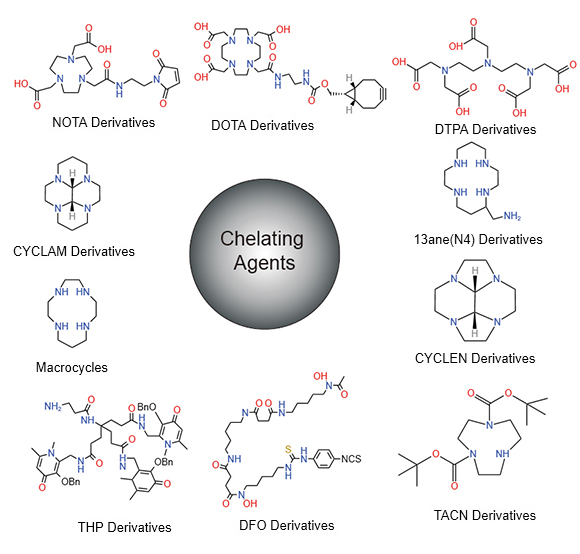The products from CD Bioparticles include specialised delivery techniques, exact drug design and modification, and cutting-edge technology platforms that can help you with:
 Figure 1. Types of Chelating Agents for Drug Development.
Figure 1. Types of Chelating Agents for Drug Development.
The challenges you might meet:
- The integrity and biological activity of encapsulated drugs are poor, and they are prone to degradation or premature release;
- Encapsulated drugs are prone to rapid release, resulting in reduced therapeutic effect, high drug toxicity, and short drug half-life;
- Poor targeting of drugs, easy to off-target;
- Delivered drugs are not easily taken up by cells;
- Difficulty in monitoring the drug in the body;
- The biocompatibility of drug and carrier in vivo is poor.
Chelating Agents Key features:
Chelating Agents Key benefits:
Chelating agents play a significant role in the field of nano drug delivery, offering several advantages and contributing to the success of targeted and efficient drug delivery systems. Here are some key roles of chelating agents in nano drug delivery:
- Encapsulation and Drug Stability: Chelating agents can be used to encapsulate drugs within nanoparticles, providing protection and stability to the drug molecules. By forming complexes with metal ions, chelating agents help to maintain the integrity and bioactivity of the encapsulated drugs, preventing degradation or premature release.
- Controlled Drug Release: Chelating agents enable controlled and sustained drug release from nanoparticles. The formation of stable chelate complexes can modulate the release kinetics of drugs, allowing for a controlled and prolonged release profile. This controlled release mechanism enhances therapeutic efficacy, reduces drug toxicity, and minimizes the need for frequent dosing.
- Targeted Drug Delivery: Chelating agents facilitate targeted drug delivery to specific sites in the body. By conjugating chelating agents to the surface of nanoparticles, it becomes possible to selectively bind and accumulate the nanoparticles at target sites, such as tumors or inflamed tissues. Chelation enables active targeting by exploiting specific receptors or ligands present at the target site, enhancing drug accumulation and reducing off-target effects.
- Enhanced Cellular Uptake: Chelating agents can enhance the cellular uptake of nanoparticles and the encapsulated drugs. The presence of chelating agents on the nanoparticle surface promotes interactions with cell membrane receptors or transporters, facilitating efficient uptake by cells. This increased cellular internalization improves drug delivery to the desired intracellular compartments, enhancing therapeutic efficacy.
- Imaging and Diagnostics: Chelating agents can be used to incorporate imaging agents or diagnostic probes into nanoparticles for simultaneous imaging and drug delivery. By chelating imaging agents, such as fluorescent dyes or contrast agents, to nanoparticles, it becomes possible to monitor drug distribution, biodistribution, and therapeutic response in real-time. This integration of imaging and drug delivery enables personalized medicine and enhances treatment monitoring.
- Theranostics: Chelating agents enable the development of theranostic nanosystems, which combine therapeutic and diagnostic capabilities. By incorporating both drugs and imaging agents into nanoparticles through chelation, theranostic platforms offer the opportunity to simultaneously deliver therapies while monitoring their efficacy. This approach contributes to personalized medicine and facilitates targeted treatments.
- Biocompatibility and Safety: Chelating agents used in nano drug delivery systems are often chosen for their biocompatibility and low toxicity. The ability of chelating agents to form stable complexes with metal ions ensures the safe and controlled release of drugs without causing undesirable side effects. Additionally, the use of biocompatible chelating agents minimizes the potential for immune reactions or toxicity in the body.
Chelating Agents Application candidates:
- Chelation enables the attachment of ligands or targeting moieties to nanoparticles, facilitating active targeting and enhancing drug delivery to desired sites.
- Chelation helps to form complexes with metal ions, providing protection and preventing the degradation of encapsulated drugs.
- By employing chelation as a trigger, drug release from nanoparticles can be controlled in response to specific stimuli such as changes in pH, temperature, or the presence of certain ions.
- Chelation-based theranostics enable real-time monitoring of drug distribution, biodistribution, and therapeutic response, facilitating personalized medicine and treatment optimization.
- Chelation-based strategies contribute to enhanced drug delivery to desired intracellular compartments, increasing therapeutic efficacy.
 Figure 1. Types of Chelating Agents for Drug Development.
Figure 1. Types of Chelating Agents for Drug Development.